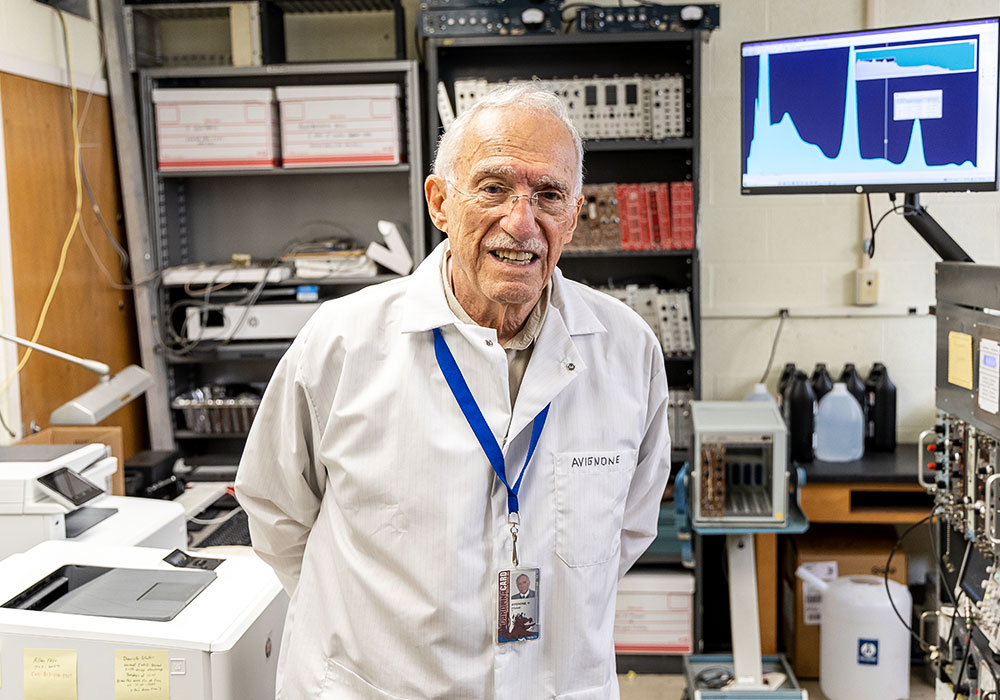Frank Avignone is looking for dark matter ― the mysterious substance that makes up much of the universe.
In a lab at the University of South Carolina, he shows off a spectrometer that he recently repaired with support from the National Science Foundation. Purchased for his lab more than 50 years ago, the device proved to be just what he needs for his newest experiment.
Avignone, age 90, thought of a way to use this spectrometer to search for the “heavy sterile neutrino,” one theoretical particle that could solve the dark matter puzzle.
“People are searching for it in all sorts of elegant ways,” Avignone says. “But I’m back to beta spectroscopy."
Many of Avignone's colleagues ― and even some of his students ― have already retired. But Avignone’s curiosity drives him to devise new experiments and seek more mysteries about the universe. You might say that for Avignone, a bad day looking for neutrinos beats a good day golfing.
Peering into darkness
Scientists have been looking for dark matter throughout Avignone’s life. In 1933, the year he was born, an astronomer suggested that some invisible mass must be present to create the amount of gravity observed in the universe. Current theories say dark matter and dark energy make up more than 90 percent of the universe.
After serving in the Korean War, Avignone studied physics at the Georgia Institute of Technology and then joined the USC faculty in 1965. He started collaborating with Fred Reines, a California-based physicist who had discovered the particles known as neutrinos at the Savannah River Laboratory, located in South Carolina’s Piedmont.
“Neutrinos are the most prolific elementary particle in the universe,” Avignone says. They’re released in the atom-splitting reactions in nuclear power plants as well as the fusion in stars. Researchers study them to explore fundamental questions about the universe, including puzzles such as antimatter and dark matter.
Reines used to tell Avignone, “We should always be working on something that could get somebody a Nobel Prize.” Even if they never made a breakthrough discovery, he said they should chase big questions and lay the groundwork for future discoveries.
Big thinking defined Avignone’s career. In the 1980s, deep in a gold mine, he ran the first dark matter experiment relying on data taken on Earth instead of astronomical observations. Over the past 20 years, he has helped create the Cryogenic Underground Observatory for Rare Events, an underground laboratory in Italy that seeks to unlock secrets of neutrinos to learn why the universe is filled with matter.
“Many of my experiments have started in a small lab here and then grown into bigger things elsewhere,” Avignone says.
A lifetime of influence
Avignone’s far-reaching impact has a lot to do with his attitude toward other scientists.
"You should mentor, not just teach,” he says. He’s hooded 29 USC doctoral students, with another one set to graduate in December. He served as department chair for nearly 20 years, allowing him to shape the careers of other faculty members and encourage them to take the same approach to mentorship.
“He likes to propel younger people further in their careers,” says Kevin Wilson, who started working as a technician for Avignone about 10 years ago. Seeing potential, Avignone recruited Wilson to study physics again, and Wilson just finished his Ph.D. under Avignone’s mentorship.
“His enthusiasm is infectious,” says Karsten Heeger, a Yale scientist who met Avignone as a graduate student in Washington and now collaborates on CUORE. “People like to work with him. He has built a large family of physicists that he has mentored and guided.”

Dozens of these scientists were in Columbia shortly after Avignone’s 90th birthday for a symposium in his honor, “Hidden Neutrinos.” One speaker was Nobel laureate Art McDonald, who spoke about being influenced by Avignone’s research.
When Avignone took the stage in the symposium, he could have recited a long list of contributions he has made to the field. Instead, he spoke about his new experiment. By adjusting the rate of the spectrometer, he hopes to find blips in data that would reveal the heavy sterile neutrino.
Avignone says he doesn’t expect to solve the dark matter puzzle during his lifetime. Any discovery could be years away, by which point he expects Heeger or another scientist to pick it up.
“For these kinds of things, you have to have patience,” he says.
For now, though, Avignone plans to continue the search that has dominated scientific imaginations throughout his lifetime.
“What's exciting about discovery is doing something that nobody has done before, putting it in the books and advancing the wall of science,” Avignone says. “As long as my health holds up, I will be happy to continue.”
